关于美国南北战争的英语演讲稿
南北战争英文作文
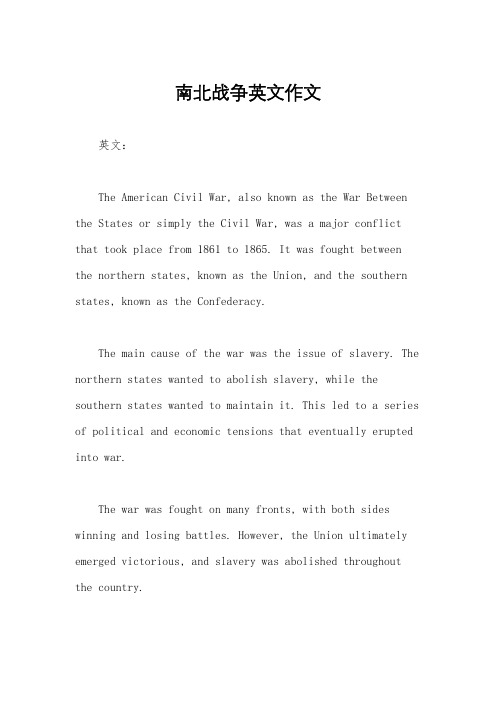
南北战争英文作文英文:The American Civil War, also known as the War Between the States or simply the Civil War, was a major conflict that took place from 1861 to 1865. It was fought between the northern states, known as the Union, and the southern states, known as the Confederacy.The main cause of the war was the issue of slavery. The northern states wanted to abolish slavery, while the southern states wanted to maintain it. This led to a series of political and economic tensions that eventually erupted into war.The war was fought on many fronts, with both sides winning and losing battles. However, the Union ultimately emerged victorious, and slavery was abolished throughout the country.The Civil War had a profound impact on American society, politics, and culture. It led to the end of slavery, the reunification of the country, and the establishment of a stronger federal government. It also had a lasting impacton the lives of millions of Americans, both during andafter the war.中文:美国内战,也称为州际战争或者简单地称为内战,是一场从1861年到1865年的重大冲突。
美国南北战争(英文版)

Prewar
America territorial expansion
Prewar
Political situation before the Civil War
Prewar
Cause 1:
The abolition of slavery
Prewar
North——capitalist industrial economy
South——plantation economy
Cause 2:
The contradiction between the north and south of two economic systems
Prewar
blasting fuse:
the election of abraham lincoln The loss of political discourse to the south
American Civil War
美国南北战争
Prewar
From France,1803
From Britain
Independence,1783
From Mexico,1845-1848
From Spain
Westward Movement and territorial expansion
A split of the house is untenable. I believe this government can not forever maintain the half-slave and half free status.
Prewar
Number of states Population Economy Property Preperation
关于美国南北战争的英语演讲稿
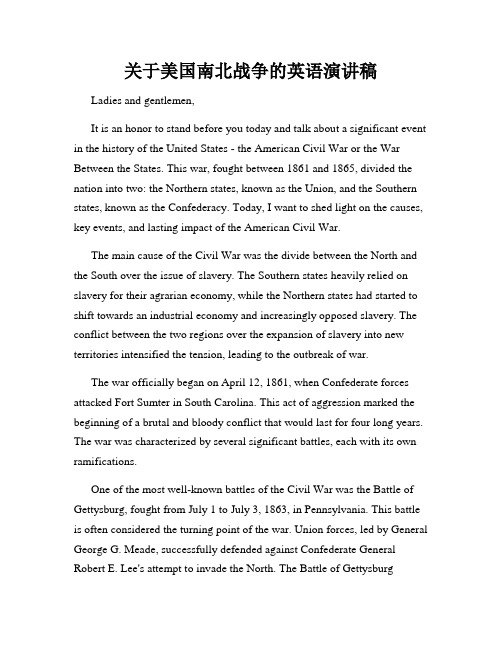
关于美国南北战争的英语演讲稿Ladies and gentlemen,It is an honor to stand before you today and talk about a significant event in the history of the United States - the American Civil War or the War Between the States. This war, fought between 1861 and 1865, divided the nation into two: the Northern states, known as the Union, and the Southern states, known as the Confederacy. Today, I want to shed light on the causes, key events, and lasting impact of the American Civil War.The main cause of the Civil War was the divide between the North and the South over the issue of slavery. The Southern states heavily relied on slavery for their agrarian economy, while the Northern states had started to shift towards an industrial economy and increasingly opposed slavery. The conflict between the two regions over the expansion of slavery into new territories intensified the tension, leading to the outbreak of war.The war officially began on April 12, 1861, when Confederate forces attacked Fort Sumter in South Carolina. This act of aggression marked the beginning of a brutal and bloody conflict that would last for four long years. The war was characterized by several significant battles, each with its own ramifications.One of the most well-known battles of the Civil War was the Battle of Gettysburg, fought from July 1 to July 3, 1863, in Pennsylvania. This battle is often considered the turning point of the war. Union forces, led by General George G. Meade, successfully defended against Confederate General Robert E. Lee's attempt to invade the North. The Battle of Gettysburgresulted in heavy casualties on both sides but halted the Confederate advance and boosted the morale of the Union army.Another crucial event was the issuance of the Emancipation Proclamation by President Abraham Lincoln on January 1, 1863. This proclamation declared that all enslaved individuals in Confederate-held territory were to be set free. Although it did not immediately free all enslaved people, it shifted the focus of the war from preserving the Union to abolishing slavery. Moreover, it allowed the recruitment of African Americans into the Union army, altering the course of the war and laying the foundation for the eventual end of slavery.As the war progressed, the Union army gained the upper hand due to its superior resources, transportation systems, and industrial capacity. Moreover, the Confederacy faced various challenges such as shortages of men and supplies, as well as internal divisions. On April 9, 1865, Confederate General Robert E. Lee surrendered to Union General Ulysses S. Grant at Appomattox Court House, effectively ending the war.The American Civil War had lasting effects on the nation. Firstly, it abolished slavery and ensured that the United States would remain a free nation. The war confirmed that no state had the right to secede from the Union and established the federal government's authority over the individual states.Additionally, the war had a profound impact on the development of the United States as an industrial power. The need for massive amounts of supplies and weaponry during the war stimulated the growth of industries in the North. The war also paved the way for technological advancements,particularly in the fields of communication and transportation. Railroads, telegraphs, and other innovations enabled better coordination and efficiency during military operations.Furthermore, the Civil War had a profound effect on the role of women in society. Women on both sides actively participated by nursing wounded soldiers, working in factories, and even disguising themselves as men to fight in the war. This engagement led to a reevaluation of women's capabilities and their contribution to society, eventually contributing to the women's suffrage movement and the fight for gender equality.In conclusion, the American Civil War left an indelible mark on the history of the United States. Its primary cause, the issue of slavery, divided the nation and ultimately led to a brutal and devastating conflict. The war's key events, such as the Battle of Gettysburg and the issuance of the Emancipation Proclamation, played crucial roles in shaping the outcome of the war. The war's enduring impact can be seen in the abolition of slavery, the nation's industrial development, advancements in communication and transportation, and the changing role of women in society. As we remember and learn from this chapter in history, let us strive to build a nation founded on unity, equality, and justice for all.Thank you.。
考研英语作文之美文范例美国南北战争
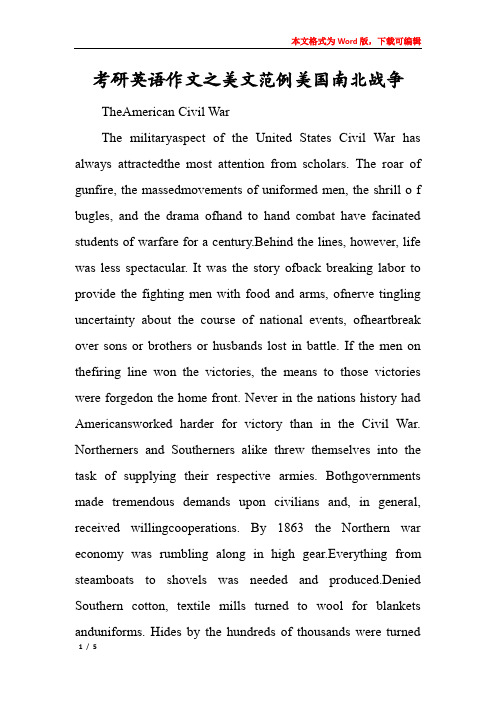
考研英语作文之美文范例美国南北战争TheAmerican Civil WarThe militaryaspect of the United States Civil War has always attractedthe most attention from scholars. The roar of gunfire, the massedmovements of uniformed men, the shrill o f bugles, and the drama ofhand to hand combat have facinated students of warfare for a century.Behind the lines, however, life was less spectacular. It was the story ofback breaking labor to provide the fighting men with food and arms, ofnerve tingling uncertainty about the course of national events, ofheartbreak over sons or brothers or husbands lost in battle. If the men on thefiring line won the victories, the means to those victories were forgedon the home front. Never in the nations history had Americansworked harder for victory than in the Civil War. Northerners and Southerners alike threw themselves into the task of supplying their respective armies. Bothgovernments made tremendous demands upon civilians and, in general, received willingcooperations. By 1863 the Northern war economy was rumbling along in high gear.Everything from steamboats to shovels was needed and produced.Denied Southern cotton, textile mills turned to wool for blankets anduniforms. Hides by the hundreds of thousands were turnedinto shoes and harness and saddles; ironworks manufactured locomotives, ordnance, armor plate. Whereprivate enterprise lagged, the government set up its own factories or arsenals.Agriculture boomed, with machinery doing the job of farm workers drawn into thearmy. In short, everything that a nation needed to fight a modern war wasproduced in uncounted numbers. Inevitably there were profiteers with gold headed canes and flamboyant diamond stickpins, but for every crooked tycoon therewere thousands of ordinary citizens living on fixed incomes who did their bestto cope with rising prices and still make a contribution to the war effort.Those who could bought war bonds; others knitted, sewed, nursed, or lent anyother assistance in their power.全文翻译:美国内战美国内战中的军事方面始终最吸引学者们的留意。
介绍一下美国内战英文作文
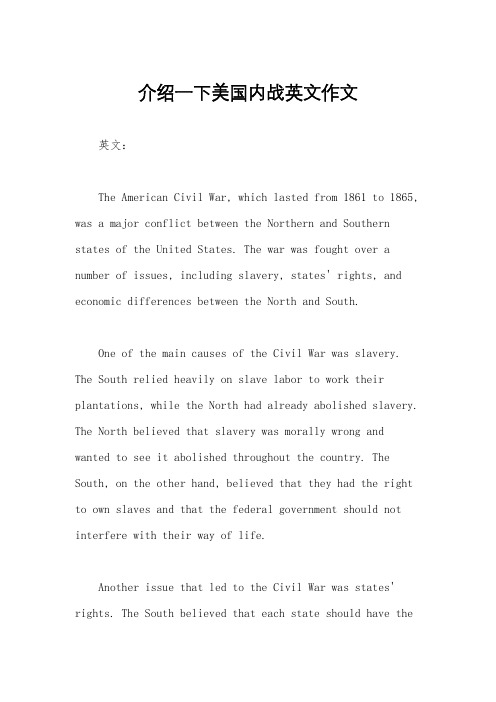
介绍一下美国内战英文作文英文:The American Civil War, which lasted from 1861 to 1865, was a major conflict between the Northern and Southern states of the United States. The war was fought over a number of issues, including slavery, states' rights, and economic differences between the North and South.One of the main causes of the Civil War was slavery. The South relied heavily on slave labor to work their plantations, while the North had already abolished slavery. The North believed that slavery was morally wrong and wanted to see it abolished throughout the country. The South, on the other hand, believed that they had the right to own slaves and that the federal government should not interfere with their way of life.Another issue that led to the Civil War was states' rights. The South believed that each state should have theright to decide whether or not to allow slavery, while the North believed that the federal government should have the power to regulate slavery.The economic differences between the North and South also played a role in the Civil War. The North was becoming more industrialized and relied on manufacturing, while the South was still primarily agricultural. The North wanted to impose tariffs on imported goods, which would have hurt the South's economy.The Civil War was a brutal conflict that resulted in the deaths of over 620,000 Americans. It also had a lasting impact on the country, as it led to the end of slavery and the reunification of the United States.中文:美国内战发生于1861年至1865年之间,是美国北部和南部州之间的一场重大冲突。
关于美国内战的英语作文
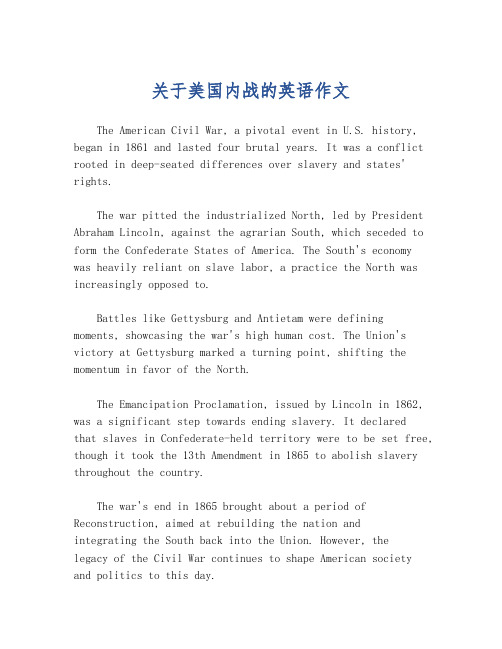
关于美国内战的英语作文The American Civil War, a pivotal event in U.S. history, began in 1861 and lasted four brutal years. It was a conflict rooted in deep-seated differences over slavery and states' rights.The war pitted the industrialized North, led by President Abraham Lincoln, against the agrarian South, which seceded to form the Confederate States of America. The South's economy was heavily reliant on slave labor, a practice the North was increasingly opposed to.Battles like Gettysburg and Antietam were defining moments, showcasing the war's high human cost. The Union's victory at Gettysburg marked a turning point, shifting the momentum in favor of the North.The Emancipation Proclamation, issued by Lincoln in 1862, was a significant step towards ending slavery. It declaredthat slaves in Confederate-held territory were to be set free, though it took the 13th Amendment in 1865 to abolish slavery throughout the country.The war's end in 1865 brought about a period of Reconstruction, aimed at rebuilding the nation andintegrating the South back into the Union. However, thelegacy of the Civil War continues to shape American society and politics to this day.The Civil War was not just a military struggle; it was a social and political upheaval that tested the very foundations of the United States. The sacrifices made by soldiers on both sides serve as a reminder of the high price of freedom and unity.。
美国南北战争英文介绍
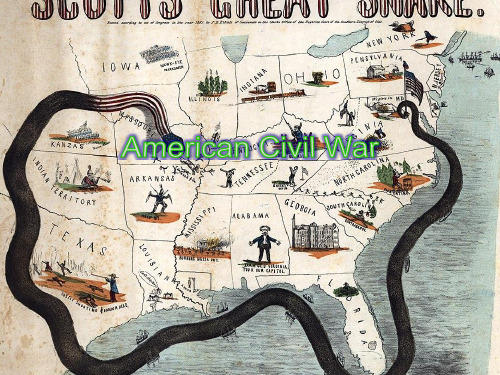
•
Union victory and aftermath
The war resulted in at least 1,030,000 casualties (3 percent of the population), including about 620,000 soldier deaths—two-thirds by disease, and 50,000 civilians. Binghamton University historian J. David Hacker believes the number of soldier deaths was approximately 750,000, 20 percent higher than traditionally estimated, and possibly as high as 850,000.The war accounted for more American deaths than in all other U.S. wars combined. 这场战争造成至少1030000人伤亡(占总人口的3%),包括620000名士 兵死亡(三分之二死于疾病)和50000名平民。宾汉顿大学的历史学家 J.David Hacker相信士兵的死亡人数大约是75万,比传统估计高出20%, 可能高达85万。
•
Influences
The Civil War destroyed slavery. The Civil War was the second bourgeois revolution (第二次资产阶级革命) in American history, it solved the peasant land problem better, safeguarded national unity, and cleared the way for the accelerated development of American capitalism. The United States has laid the foundation for being among the world's powers.
南北战争作文
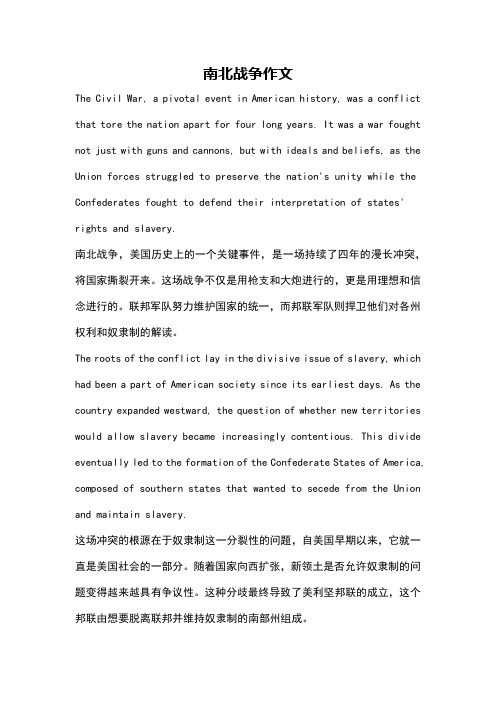
南北战争作文The Civil War, a pivotal event in American history, was a conflict that tore the nation apart for four long years. It was a war fought not just with guns and cannons, but with ideals and beliefs, as the Union forces struggled to preserve the nation's unity while the Confederates fought to defend their interpretation of states' rights and slavery.南北战争,美国历史上的一个关键事件,是一场持续了四年的漫长冲突,将国家撕裂开来。
这场战争不仅是用枪支和大炮进行的,更是用理想和信念进行的。
联邦军队努力维护国家的统一,而邦联军队则捍卫他们对各州权利和奴隶制的解读。
The roots of the conflict lay in the divisive issue of slavery, which had been a part of American society since its earliest days. As the country expanded westward, the question of whether new territories would allow slavery became increasingly contentious. This divide eventually led to the formation of the Confederate States of America, composed of southern states that wanted to secede from the Union and maintain slavery.这场冲突的根源在于奴隶制这一分裂性的问题,自美国早期以来,它就一直是美国社会的一部分。
- 1、下载文档前请自行甄别文档内容的完整性,平台不提供额外的编辑、内容补充、找答案等附加服务。
- 2、"仅部分预览"的文档,不可在线预览部分如存在完整性等问题,可反馈申请退款(可完整预览的文档不适用该条件!)。
- 3、如文档侵犯您的权益,请联系客服反馈,我们会尽快为您处理(人工客服工作时间:9:00-18:30)。
关于美国南北战争的英语演讲稿篇一:美国内战中英文介绍1.Civil WarThe American Civil War (1861–1865), often referred to simply as The Civil War in the United States, was a civil war fought in the United States of America. In response to the election of Abraham Lincoln as President of the United States, 11 southern slave states declared their secession from the United States and formed the Confederate States of America ("the Confederacy"); the other 25 states supported the federal government ("the Union"). After four years of warfare, mostly within the Southern states, the Confederacy surrendered and slavery was outlawed everywhere in the nation. Issues that led to war were partially resolved in the Reconstruction Era that followed, though others remained uesolved.In the presidential election of 1860, the Republican Party, led by Abraham Lincoln, had campaigned against expanding slavery beyond the states in which it already existed. The Republicans strongly advocated nationalism, and in their 1860 platform theydenounced threats of disunion as avowals of treason. After a Republican victory, but before the new administration took office on March 4, 1861, seven cotton states declared their secession and joined to form the Confederate States of America. Both the outgoing administration of President James Buchanan and the incoming administration rejected the legality of secession, considering it rebellion. The other eight slave states rejected calls for secession at this point. No country in the world recognized the Confederacy.Hostilities began on April 12, 1861, when Confederate forces attacked a military installation at Fort Sumter in South Carolina. Lincoln responded by calling for a volunteer army from each state to recapture federal property, which led to declarations of secession by four more slave states. Both sides raised armies as the Union seized control of the border states early in the war and established a naval blockade. Land warfare in the East was inconclusive in 1861–62, as the Confederacy beat back Union efforts to capture its capital, Richmond, Virginia, notably during the Peninsular Campaign. In September 1862, theConfederate campaign in Maryland ended in defeat at the Battle of Antietam, which dissuaded the British from intervening.[2] Days after that battle, Lincoln issued the Emancipation Proclamation, which made ending slavery a war goal.[3]In 1863, Confederate general Robert E. Lee's northward advance ended in defeat at the Battle of Gettysburg. To the west, the Union gained control of the Mississippi River after the Battle of Shiloh and Siege of Vicksburg, splitting the Confederacy in two and destroying much of their western army. Due to his western successes, Ulysses S. Grant was given command of the eastern army in 1864, and organized the armies of William Tecumseh Sherman, Philip Sheridan and others to attack the Confederacy from all directions, increasing the North's advantage in manpower. Grant restructured the union army, and put other generals in command of divisions of the army that were to support his push into Virginia. He fought several battles of attrition against Leethrough the Overland Campaign to seize Richmond, though in the face of fierce resistance he altered hisplans and led the Siege of Petersburg which nearly finished off the rest of Lee's army. Meanwhile, Sherman captured Atlanta and marched to the sea, destroying Confederate infrastructure along the way. When the Confederate attempt to defend Petersburg failed, the Confederate army retreated but was pursued and defeated, which resulted in Lee's surrender to Grant at Appomattox Court House on April 9, 1865.The American Civil War was one of the earliest true industrial wars. Railroads, the telegraph, steamships, and mass-produced weapons were employed extensively. The practices of total war, developed by Sherman in Georgia, and of trench warfare around Petersburg foreshadowed World War I in Europe. It remains the deadliest war in American history, resulting in the deaths of 620,000 soldiers and an undetermined number of civilian casualties. Historian John Huddleston estimates the death toll at ten percent of all Northern males 20–45 years old, and 30 percent of all Southern white males aged 18–40.[4] Victory for the North meant the end of the Confederacy and of slavery in the United States, and strengthened the roleof the federal government. The social, political, economic and racial issues of the war decisively shaped the reconstruction era that lasted to 1877.美国南北战争(1861-1865),通常被称为在美国南北战争,是一场内战,战斗在美利坚合众国。
